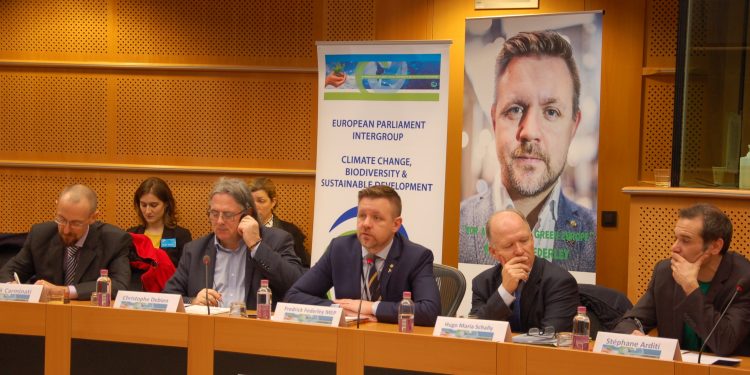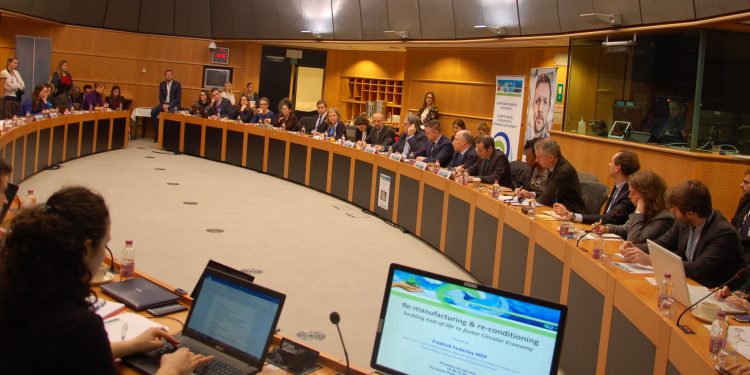
- This event has passed.
Re-manufacturing & re-conditioning: Tackling end-of-life to foster Circular Economy
January 25, 2018 @ 10:30 - 12:30

Chaired by:
Fredrick Federley MEP
Chair of the “Circular Economy and Raw Materials” Working Group of the EP Intergroup on
“Climate Change, Biodiversity and Sustainable Development”
Policy-makers, industry, NGOs, and stakeholders gathered in the European Parliament to discuss the potential of re-manufacturing and re-conditioning, which increase the lifetime of products by rebuilding and repairing them. Further, participants helped to identify barriers and suggested key actions to support the future of re-manufacturing and re-conditioning.
Fredrick Federley MEP and Chair of the “Circular Economy & Raw Materials” Working Group of the EP Intergroup on “Climate Change, Biodiversity, and Sustainable Development” welcomed participants by underlining that re-manufacturing and re-conditioning are important parts of the circular economy and are relevant for many legislative proposals. It was added that there is a huge potential for economic growth, environmental sustainability and better resource efficiency. It was mentioned that the US has a stronger economy when it comes to circularity compared to Europe. However, there is a huge potential for the reuse of materials in the EU economic system and the possibility for economic growth using the same resources. It is estimated that the life-cycle of products can be extended from 2 to 9 times, which will have a significant impact on extracted resources. However, there are several barriers to further developing the circular economy highlighting the importance of inputs from stakeholders to provide also insight on how to best tackle such barriers.
Hugo Maria Schally, Head of Unit Sustainable Production, Consumption and Products, DG ENVI, European Commission emphasised that the Commission is racing to meet the expectations of stakeholders, live up to its commitments to the circular economy, as well as consider what else is needed to facilitate the transition. The Commission from the very beginning had clearly stated that re-manufacturing and re-conditioning contribute to increasing the circularity of the EU economic system. He further recognised that in the US certain sectors and companies had may be quite circular in areas where it makes economic sense, but also highlighted that the EU has a constructive dialogue on circularity with China where there are many initiatives underway. The EU will however continue to engage with the US and other international partners not least in the context of the G7 and G 20.. It was said that the circular economy package identified a number of opportunities that can be used to extend the life of products beyond the first cycle of use. In that sense the package includes a number of measures that together should support the move in that direction namely by enhanced emphasis on the role of public procurement as well as making buyers and consumers aware of the added value of re-manufactured and re-conditioned products to counter the perception that such products are not of the same quality as new ones, which makes it preferable to buy new products. Together with colleagues in DG JUST and DG GROW the Commission is putting a lot of emphasis to convey the message to look at the overall quality of the product. Quality may entail factors such as functionality, price, resource and environmental performance of the product also underlining the need to reach those consumers and buyers that take such parameters into consideration. The ambition of making use of the regulatory framework governing public procurement in support of strategic objectives of public policy was raised. It was said that the Commission aims to remove any obstacles of purchasing re-manufactured and re-conditioned products. However, in the context of looking at reuse of re-manufactured and re-conditioned products at the end of the first cycle it must also be taken into account the technological and environmental standards of substances and the recognition of whether certain substances are harmful. It was said that reuse, re-manufacturing and re-conditioning must respect the environmental and safety standards. With regards to recycling it was said that re-manufacturing can never be an end in itself. One obstacle to further discuss is products that may contain substances, which were not identified as a problem ten years ago, but may be a problem today. The issue there will be whether the substance is a problem in the course of production or in the course of use. This must also be considered at the eventual recycling of the material. It was said that it is important to also respect the product specific approach and to consider where the innovation should be applied. Further, full value chain cooperation is pivotal and the need to look at the preconditions for viable business models was mentioned. In the regulatory sense it was said to look at the trade-offs as well as whether the right technical standards are in place. It was said that it will be important to further exchange with stakeholders to discuss the challenges and solutions. The measures and actions proposed in the recent Communication on the interface between chemical, product and waste legislation will also be important for stakeholders in this regard.
Christophe Debien, General Director, French Circular Economy Institute informed that the institute was founded in 2013 with the mission to promote the circular economy and accelerate its implementation through a collaborative approach particularly focusing on re-manufacturing. Although there is no precise assessment of the scale of re-manufacturing it is estimated on the global market to be around 100 million Euros. It was said that the market is increasing and it is expected to continue in the coming years. The institute, a multi-stakeholder association, also works closely with industries which have a strong interest in re-manufacturing. In particular, Michelin is an important partner of the institute. It was said that all the products cannot be re-manufactured, but there are many sectors that can and do work on further progressing in this area such as the automotive industry, transport, and electronics. It is true that it needs to be more developed, especially in the framework of a circular economy. It was said that re-manufacturing and re-conditioning makes economic sense as the refurbished products are more profitable and sustainable. Further, such products also help to create a new market also advancing these products and providing room for changes and modifications. With regards to the social domain, re-manufacturing is important for regional and local jobs. The re-manufacturing process of retreading was also mentioned, with regards to the tyre industry, as it optimises the use of resources and helps ensure sustainable employment. It was explained that retreading is often unknown by the general public, but common in professional circles, particularly since 2015. Reference was further made to the recent study conducted on the subject “The socio-economic impact of truck tyre retreading in Europe”. Statistics show that 40 % of heavy weighted tyres sold in France, 2015 were retreaded playing a significant part in the automotive economy. However, retreading factories are being closed due to the surge of imported low-price, single-use tyres. . It was said that they are opening financial markets for tyres as well as creating economic models that are more interesting for consumers due to lower prices. It was said that a new Asian tyre normally has a lower price than a retreaded tyre from Europe. The environmental characteristics of retreating was emphasised underlining the importance of eco-design and the importance of reusing natural resources. It was said that retreaded tyres use 70 % less of raw materials. In addition, retreading creates 32 000 jobs in the EU today. It was said that retreading has more social value, uses 29% less of soils, emits 24% less CO2, provides 20% less air pollution, and uses 19% less water. In conclusion, it was informed that France recently created its own roadmap for circular economy. The Institute also works closely with the French Ministry of Ecology. Circular economy is a necessity and re-manufacturing is one of its key elements.
Patrick Carminati, Head of Sourcing and Manufacturing, Lexmark outlined in his presentation the success of the company in terms of working on design to re-manufacturing, particularly of laser cartridges for more than 20 years. It was said that an empty laser cartridge is made of around 80% plastic, which can be recycled. With regards to defining re-manufacturing it was said that from the consumer perspective it should ensure the same performance as a new product. However, today there is a perception that re-manufactured products have a lower performance value. This is important for producers as it involves dismantling the product, restoring and replacing components and testing the individual parts and whole product to ensure that it is within its origin design It was highlighted that successful re-manufacturing is based not only on re-manufacturable products, but is also about getting the product into the re-manufacturing process. Further, collection of the product is one of the main challenges they face. It was explained that in 2012 laser cartridges placed on the market in Europe were not produced in Europe, but rather being imported from Mexico and China. A decision was taken to analysis the potential of regional manufacturing in Europe. It was explained that when examining the manufacturing cost as well as the total landed cost the EU was not competitive. It was therefore decided to add re-manufacturing benefits and to start re-manufacturing in Europe, extending the cycle of re-furbishing, even if only for some parts. It was said that this turned into a great success and in 2017, 45% of units sold by Lexmark in Europe were made in the EU. It has also provided environmental and business benefits as well as job creation. It was pointed out that the company does not have a re-manufacturing plant. The products are re-manufactured in the same line by the same people, with the same equipment and process ensuring the same quality standard. With regards to the future it was said that in 2020, 75% of the product that will be placed on the market in the EU will be made in the EU also further providing its extended benefits. Further, in order to be more circular Lexmark continues to develop its processes. The importance of recycling was also raised as all parts can still not be re-manufactured. It was explained that there is some loss but Lexmark aims to replicate the model of full dismantling, which already exist in Mexico in order to maximise the component reuse and to sort materials and supply them back to component manufacturers for re-use in their products. It was highlighted that in 2015, 50 kMt of cartridges, mostly made of plastic, were landfilled or incinerated in Europe. The aim is to reduce this to zero because of the pollution and waste created by this process. In order to improve the situation it was said to promote collecting, sorting, dismantling & re-manufacturing of empties. The perception of the customers must also be changed by showing the high performance and by developing trust among consumers. Green public procurement can play a significant and it was said that companies need to have industry targets. Incentives for cross industry initiatives could also be also useful. It was concluded that measures must increase the return and generate more demand for re-manufactured products.
Stéphane Arditi, Circular Economy Policy Manager, European Environmental Bureau (EEB) outlined that a proper definition is needed for re-manufacturing as it would be indispensable for policy considerations. It was said that this is one of the main challenges to meet. It was further stressed that re-manufacturing does not entail re-used or second-hand products, meaning that re-manufactured products should align with the standards of the primary product. It was reiterated that this creates another challenge as they must meet the same health, environmental and safety standards. In terms of communication it was said that another challenge may arise. One might think that a re-manufactured product should have a lower price, which would result in the expected social economic benefits such as economic viability are endangered because they cannot compete with brand-new products. The need for smart public policy was raised in order to ensure a market for re-manufactured products. With regard to possible public policy option, it has been suggested that specific targets can help, as it has been the case for recycling targets for example. The need for a certification scheme for the product is also needed in order to provide incentives. Further, it might be difficult or even impossible to measure the progress without such a scheme. In this sense it might be reasonable to work with core of total reuse of the products underlining that a product can be defined as re-manufactured only if it has for example 80% of its core versus new parts. As to the policy development the use of economic instruments was raised. For instance it was said that for some products the extended producer responsibility schemes could be used. It could also be included in green public procurement or eco-labelling. It was also suggested to look into labelling as it could help to raise awareness also calling for the need to better inform consumers. The need for proper collection is also pivotal. It was reiterated that it is possible to set collection targets. It was highlighted that the unique competence of EU is to set product standards in the single EU market. It was said that the EU should further discuss the possibility to specify design so that the potential for re-manufacturing is created. Therefore, it was suggested that if these conditions for re-manufacturable products are not created, then it will be impossible to reach significant progress with re-manufacturing. It was concluded by stating that the challenge ahead is whether we can one day consider re-manufactured and re-conditioned products to be as good as or even better than new ones. The significant environmental benefits were reiterated also calling for making re-manufactured goods the new norm.
The discussion with the audience reiterated the importance of re-manufacturing and re-conditioning. It was mentioned that Member States are required to incentivise this under the waste package and need to find their own response on how best to do so. It was highlighted that some organisations have established internal certification schemes to show consumers that re-manufactured products and equipment is feasible. The sectors will also need regulatory support in its transition. With regards to whether a definition is needed on re-manufacturing the views of stakeholders differed. On the one side it was said that it is important to have a definition for the legal framework, and on the other it was highlighted that rather than a definition actions are needed. With regards to chemicals it was said that more needs to be discussed as certain standards do not allow for remanufacturing or recycling. Remanufacturing may also become a trade issue as certain countries tax re-manufactured goods higher compared to new ones. The importance of eco-design was raised as it has shown to trigger innovation, and the importance of reuse was stressed. It was highlighted that many sectors are working on re-manufacturing and it is important to emphasis successes and best practices. It was also informed that in certain sectors legislation is still hampering circularity. The links with China was raised underlining that they plan to enter the business to consumers market for re-manufactured products, which could also lead to further opportunities in Europe if considered.
Fredrick Federley MEP and Chair concluded the meeting by stating that it will be not an easy task for legislation to find solutions, which will be applicable to all sectors. However, as the EU moves forward on its commitments to the circular economy re-manufacturing and re-conditioning will continue to be important priorities.




